A Deep Dive into Howard Gardner's Theory of Multiple Intelligences
VerifiedAdded on 2023/01/20
|5
|903
|73
Essay
AI Summary
This essay provides an in-depth analysis of Howard Gardner's theory of multiple intelligences, arguing that it offers the best representation of human intelligence. The essay outlines the different types of intelligence proposed by Gardner, including visual-spatial, linguistic-verbal, logical-mathematical, bodily-kinesthetic, musical, interpersonal, intrapersonal, and naturalistic intelligence. Each type is explained with examples, highlighting how individuals with specific intelligences excel in different areas. The author supports their claims with research, referencing sources to validate the theory. Furthermore, the essay explains how a test could be designed to reflect Gardner's theory, incorporating different tasks and assessments to evaluate various types of intelligence in individuals. The conclusion emphasizes the importance of understanding and recognizing diverse intelligences for comprehensive human development.
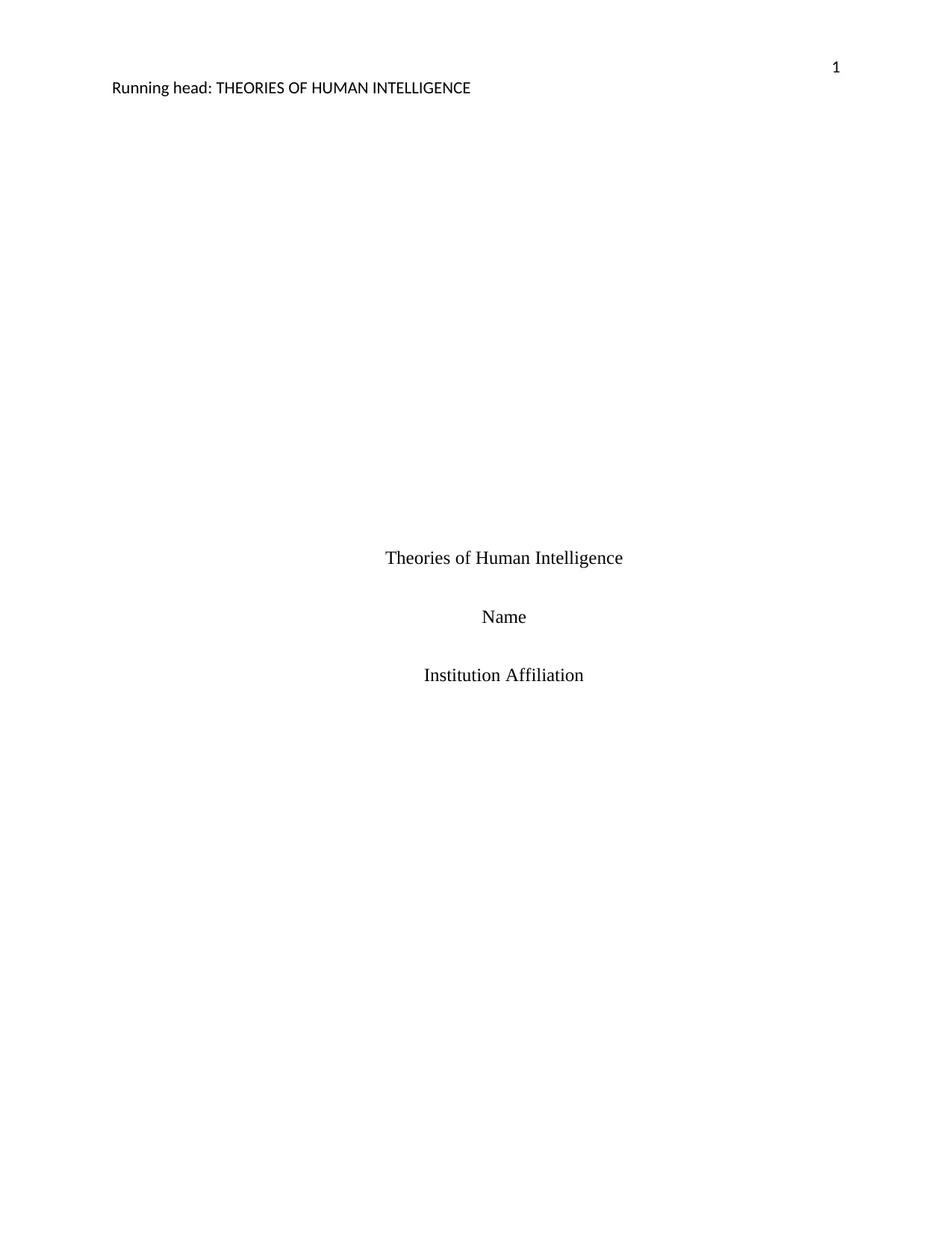
1
Running head: THEORIES OF HUMAN INTELLIGENCE
Theories of Human Intelligence
Name
Institution Affiliation
Running head: THEORIES OF HUMAN INTELLIGENCE
Theories of Human Intelligence
Name
Institution Affiliation
Paraphrase This Document
Need a fresh take? Get an instant paraphrase of this document with our AI Paraphraser
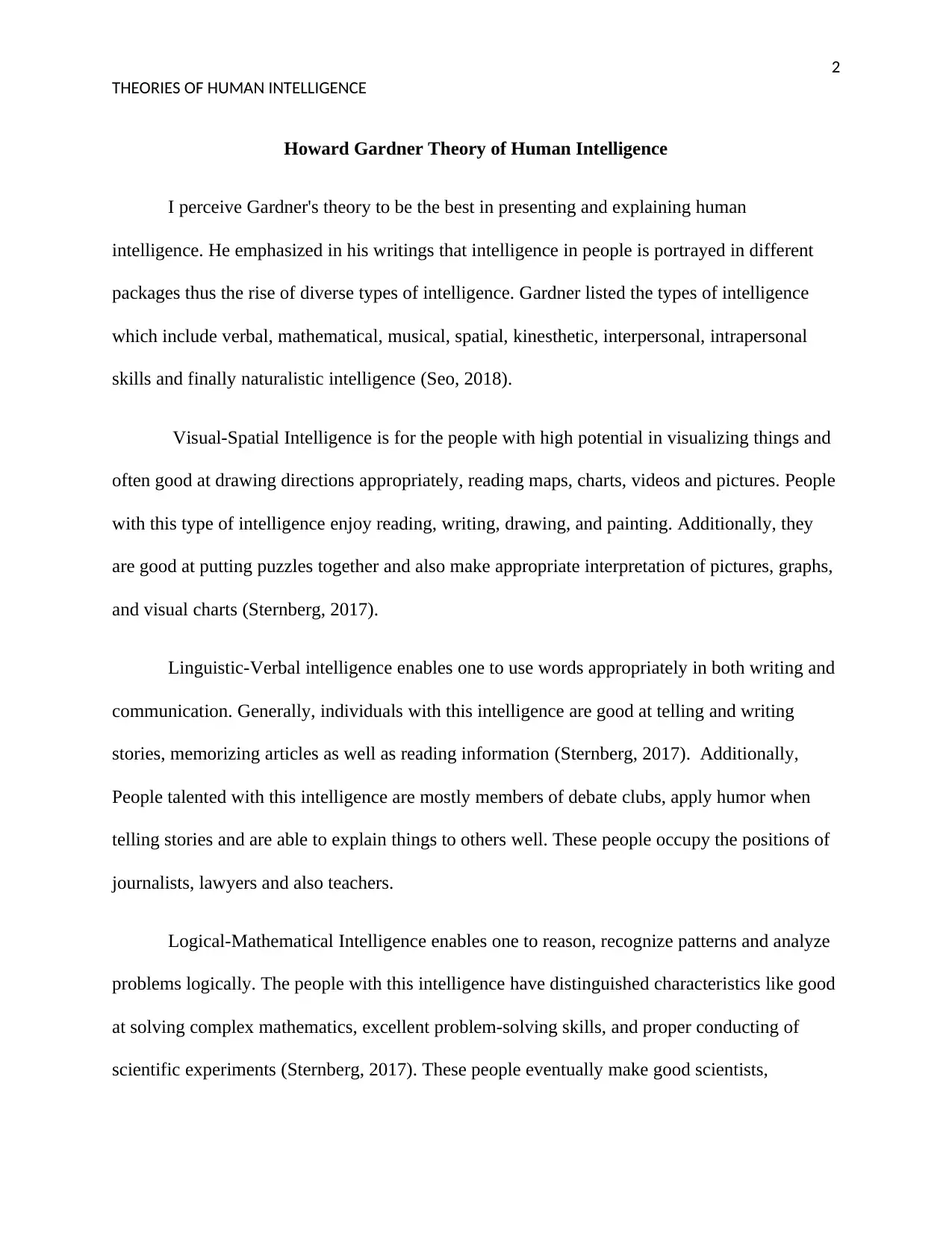
2
THEORIES OF HUMAN INTELLIGENCE
Howard Gardner Theory of Human Intelligence
I perceive Gardner's theory to be the best in presenting and explaining human
intelligence. He emphasized in his writings that intelligence in people is portrayed in different
packages thus the rise of diverse types of intelligence. Gardner listed the types of intelligence
which include verbal, mathematical, musical, spatial, kinesthetic, interpersonal, intrapersonal
skills and finally naturalistic intelligence (Seo, 2018).
Visual-Spatial Intelligence is for the people with high potential in visualizing things and
often good at drawing directions appropriately, reading maps, charts, videos and pictures. People
with this type of intelligence enjoy reading, writing, drawing, and painting. Additionally, they
are good at putting puzzles together and also make appropriate interpretation of pictures, graphs,
and visual charts (Sternberg, 2017).
Linguistic-Verbal intelligence enables one to use words appropriately in both writing and
communication. Generally, individuals with this intelligence are good at telling and writing
stories, memorizing articles as well as reading information (Sternberg, 2017). Additionally,
People talented with this intelligence are mostly members of debate clubs, apply humor when
telling stories and are able to explain things to others well. These people occupy the positions of
journalists, lawyers and also teachers.
Logical-Mathematical Intelligence enables one to reason, recognize patterns and analyze
problems logically. The people with this intelligence have distinguished characteristics like good
at solving complex mathematics, excellent problem-solving skills, and proper conducting of
scientific experiments (Sternberg, 2017). These people eventually make good scientists,
THEORIES OF HUMAN INTELLIGENCE
Howard Gardner Theory of Human Intelligence
I perceive Gardner's theory to be the best in presenting and explaining human
intelligence. He emphasized in his writings that intelligence in people is portrayed in different
packages thus the rise of diverse types of intelligence. Gardner listed the types of intelligence
which include verbal, mathematical, musical, spatial, kinesthetic, interpersonal, intrapersonal
skills and finally naturalistic intelligence (Seo, 2018).
Visual-Spatial Intelligence is for the people with high potential in visualizing things and
often good at drawing directions appropriately, reading maps, charts, videos and pictures. People
with this type of intelligence enjoy reading, writing, drawing, and painting. Additionally, they
are good at putting puzzles together and also make appropriate interpretation of pictures, graphs,
and visual charts (Sternberg, 2017).
Linguistic-Verbal intelligence enables one to use words appropriately in both writing and
communication. Generally, individuals with this intelligence are good at telling and writing
stories, memorizing articles as well as reading information (Sternberg, 2017). Additionally,
People talented with this intelligence are mostly members of debate clubs, apply humor when
telling stories and are able to explain things to others well. These people occupy the positions of
journalists, lawyers and also teachers.
Logical-Mathematical Intelligence enables one to reason, recognize patterns and analyze
problems logically. The people with this intelligence have distinguished characteristics like good
at solving complex mathematics, excellent problem-solving skills, and proper conducting of
scientific experiments (Sternberg, 2017). These people eventually make good scientists,
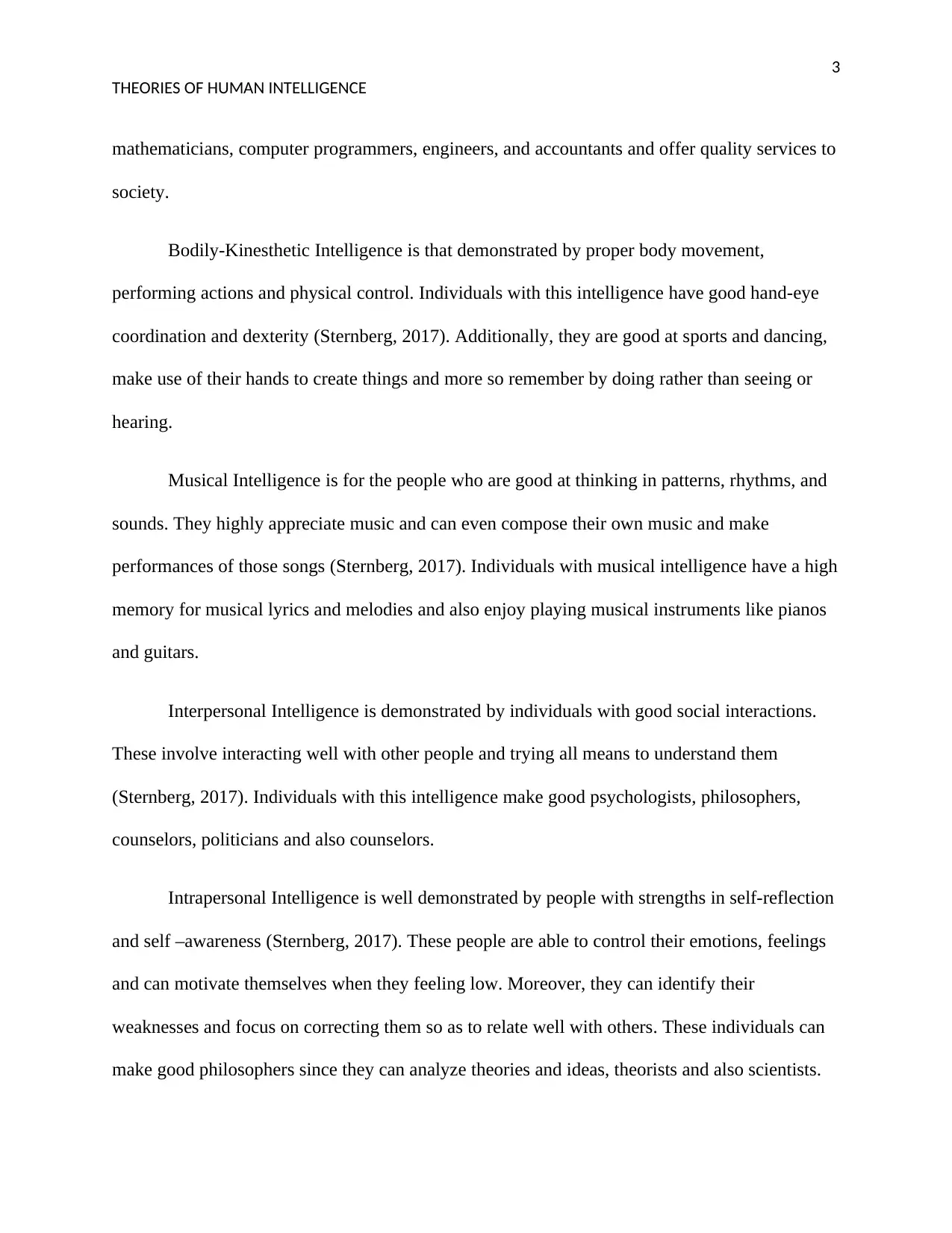
3
THEORIES OF HUMAN INTELLIGENCE
mathematicians, computer programmers, engineers, and accountants and offer quality services to
society.
Bodily-Kinesthetic Intelligence is that demonstrated by proper body movement,
performing actions and physical control. Individuals with this intelligence have good hand-eye
coordination and dexterity (Sternberg, 2017). Additionally, they are good at sports and dancing,
make use of their hands to create things and more so remember by doing rather than seeing or
hearing.
Musical Intelligence is for the people who are good at thinking in patterns, rhythms, and
sounds. They highly appreciate music and can even compose their own music and make
performances of those songs (Sternberg, 2017). Individuals with musical intelligence have a high
memory for musical lyrics and melodies and also enjoy playing musical instruments like pianos
and guitars.
Interpersonal Intelligence is demonstrated by individuals with good social interactions.
These involve interacting well with other people and trying all means to understand them
(Sternberg, 2017). Individuals with this intelligence make good psychologists, philosophers,
counselors, politicians and also counselors.
Intrapersonal Intelligence is well demonstrated by people with strengths in self-reflection
and self –awareness (Sternberg, 2017). These people are able to control their emotions, feelings
and can motivate themselves when they feeling low. Moreover, they can identify their
weaknesses and focus on correcting them so as to relate well with others. These individuals can
make good philosophers since they can analyze theories and ideas, theorists and also scientists.
THEORIES OF HUMAN INTELLIGENCE
mathematicians, computer programmers, engineers, and accountants and offer quality services to
society.
Bodily-Kinesthetic Intelligence is that demonstrated by proper body movement,
performing actions and physical control. Individuals with this intelligence have good hand-eye
coordination and dexterity (Sternberg, 2017). Additionally, they are good at sports and dancing,
make use of their hands to create things and more so remember by doing rather than seeing or
hearing.
Musical Intelligence is for the people who are good at thinking in patterns, rhythms, and
sounds. They highly appreciate music and can even compose their own music and make
performances of those songs (Sternberg, 2017). Individuals with musical intelligence have a high
memory for musical lyrics and melodies and also enjoy playing musical instruments like pianos
and guitars.
Interpersonal Intelligence is demonstrated by individuals with good social interactions.
These involve interacting well with other people and trying all means to understand them
(Sternberg, 2017). Individuals with this intelligence make good psychologists, philosophers,
counselors, politicians and also counselors.
Intrapersonal Intelligence is well demonstrated by people with strengths in self-reflection
and self –awareness (Sternberg, 2017). These people are able to control their emotions, feelings
and can motivate themselves when they feeling low. Moreover, they can identify their
weaknesses and focus on correcting them so as to relate well with others. These individuals can
make good philosophers since they can analyze theories and ideas, theorists and also scientists.
⊘ This is a preview!⊘
Do you want full access?
Subscribe today to unlock all pages.

Trusted by 1+ million students worldwide
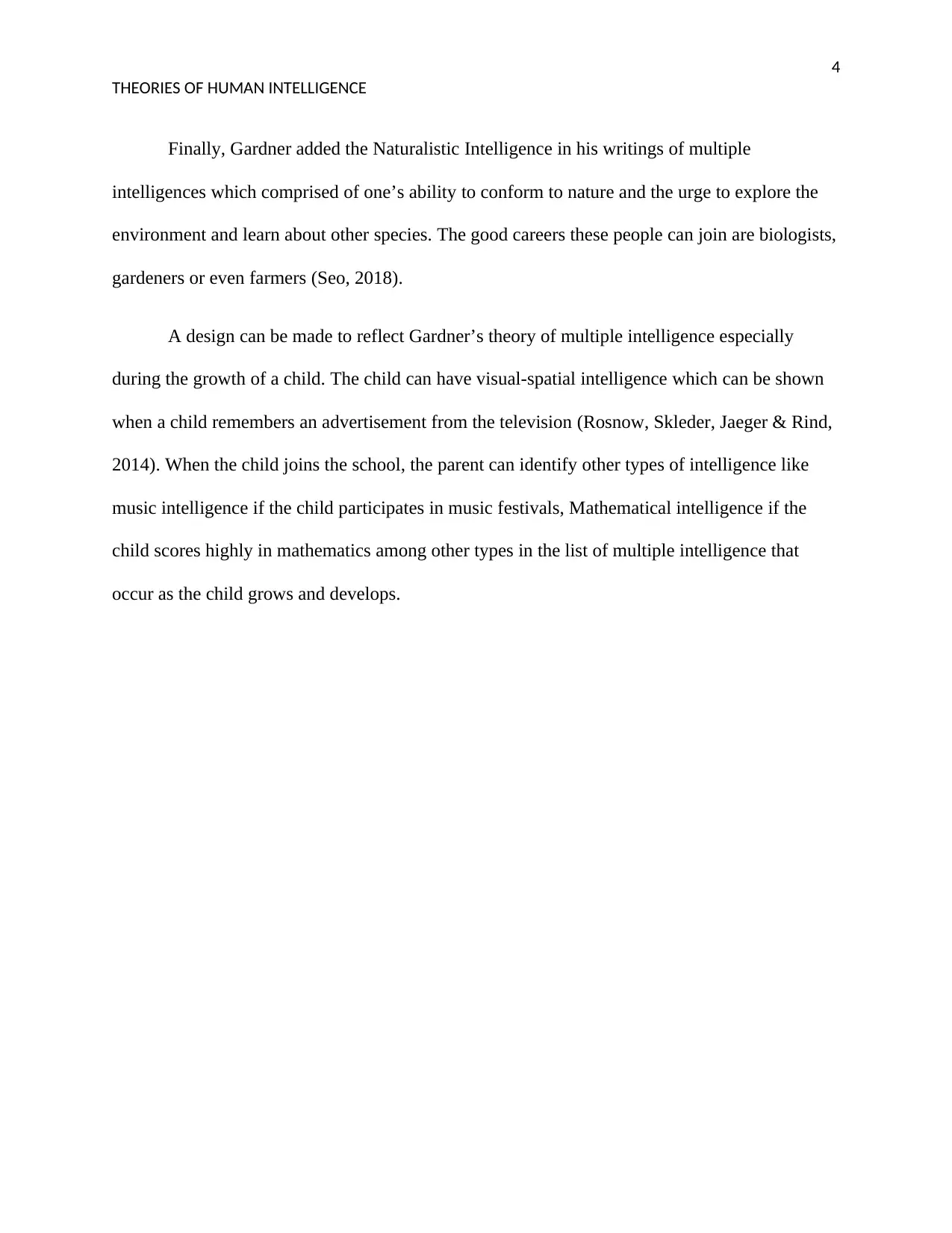
4
THEORIES OF HUMAN INTELLIGENCE
Finally, Gardner added the Naturalistic Intelligence in his writings of multiple
intelligences which comprised of one’s ability to conform to nature and the urge to explore the
environment and learn about other species. The good careers these people can join are biologists,
gardeners or even farmers (Seo, 2018).
A design can be made to reflect Gardner’s theory of multiple intelligence especially
during the growth of a child. The child can have visual-spatial intelligence which can be shown
when a child remembers an advertisement from the television (Rosnow, Skleder, Jaeger & Rind,
2014). When the child joins the school, the parent can identify other types of intelligence like
music intelligence if the child participates in music festivals, Mathematical intelligence if the
child scores highly in mathematics among other types in the list of multiple intelligence that
occur as the child grows and develops.
THEORIES OF HUMAN INTELLIGENCE
Finally, Gardner added the Naturalistic Intelligence in his writings of multiple
intelligences which comprised of one’s ability to conform to nature and the urge to explore the
environment and learn about other species. The good careers these people can join are biologists,
gardeners or even farmers (Seo, 2018).
A design can be made to reflect Gardner’s theory of multiple intelligence especially
during the growth of a child. The child can have visual-spatial intelligence which can be shown
when a child remembers an advertisement from the television (Rosnow, Skleder, Jaeger & Rind,
2014). When the child joins the school, the parent can identify other types of intelligence like
music intelligence if the child participates in music festivals, Mathematical intelligence if the
child scores highly in mathematics among other types in the list of multiple intelligence that
occur as the child grows and develops.
Paraphrase This Document
Need a fresh take? Get an instant paraphrase of this document with our AI Paraphraser
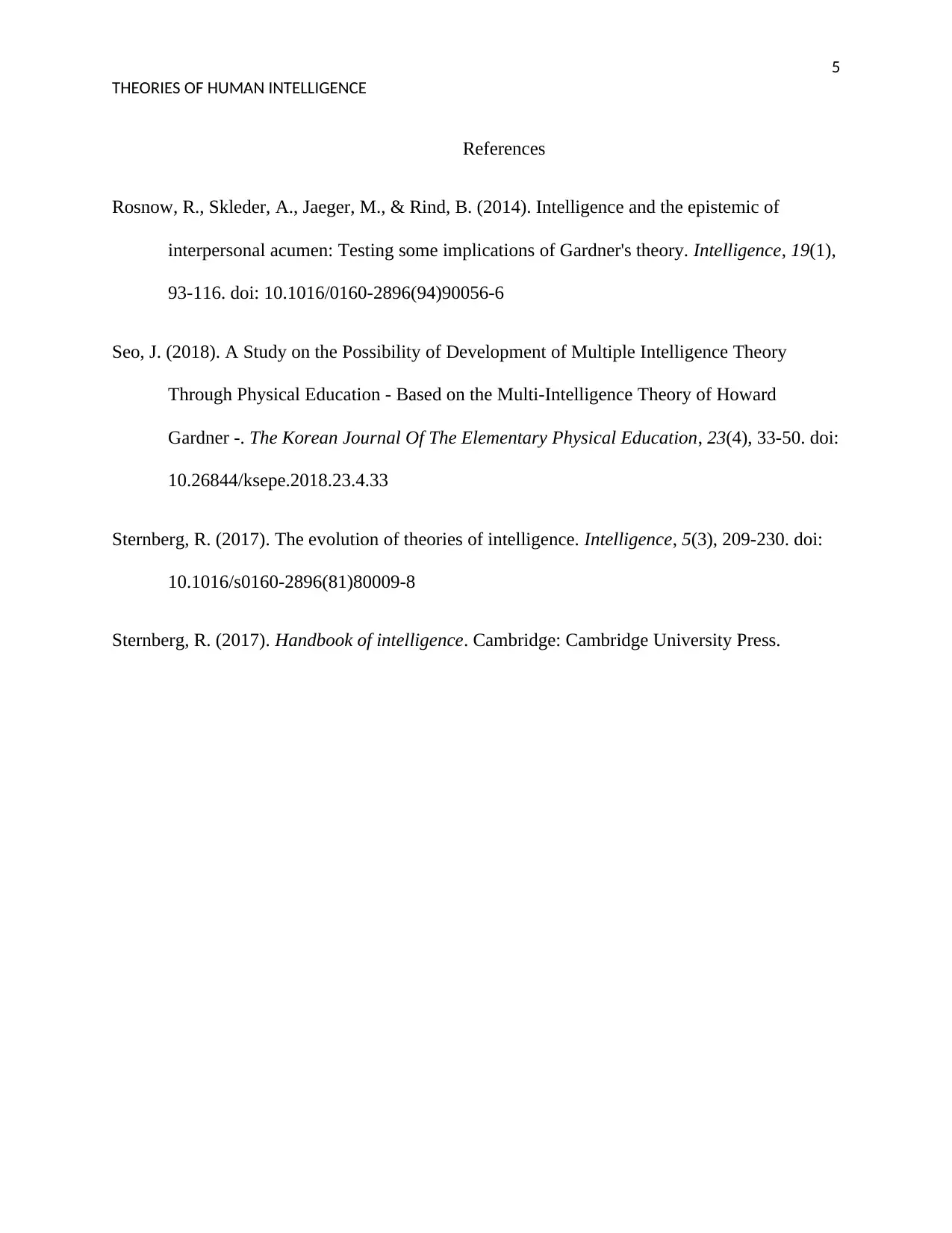
5
THEORIES OF HUMAN INTELLIGENCE
References
Rosnow, R., Skleder, A., Jaeger, M., & Rind, B. (2014). Intelligence and the epistemic of
interpersonal acumen: Testing some implications of Gardner's theory. Intelligence, 19(1),
93-116. doi: 10.1016/0160-2896(94)90056-6
Seo, J. (2018). A Study on the Possibility of Development of Multiple Intelligence Theory
Through Physical Education - Based on the Multi-Intelligence Theory of Howard
Gardner -. The Korean Journal Of The Elementary Physical Education, 23(4), 33-50. doi:
10.26844/ksepe.2018.23.4.33
Sternberg, R. (2017). The evolution of theories of intelligence. Intelligence, 5(3), 209-230. doi:
10.1016/s0160-2896(81)80009-8
Sternberg, R. (2017). Handbook of intelligence. Cambridge: Cambridge University Press.
THEORIES OF HUMAN INTELLIGENCE
References
Rosnow, R., Skleder, A., Jaeger, M., & Rind, B. (2014). Intelligence and the epistemic of
interpersonal acumen: Testing some implications of Gardner's theory. Intelligence, 19(1),
93-116. doi: 10.1016/0160-2896(94)90056-6
Seo, J. (2018). A Study on the Possibility of Development of Multiple Intelligence Theory
Through Physical Education - Based on the Multi-Intelligence Theory of Howard
Gardner -. The Korean Journal Of The Elementary Physical Education, 23(4), 33-50. doi:
10.26844/ksepe.2018.23.4.33
Sternberg, R. (2017). The evolution of theories of intelligence. Intelligence, 5(3), 209-230. doi:
10.1016/s0160-2896(81)80009-8
Sternberg, R. (2017). Handbook of intelligence. Cambridge: Cambridge University Press.
1 out of 5
Related Documents
Your All-in-One AI-Powered Toolkit for Academic Success.
+13062052269
info@desklib.com
Available 24*7 on WhatsApp / Email
![[object Object]](/_next/static/media/star-bottom.7253800d.svg)
Unlock your academic potential
Copyright © 2020–2025 A2Z Services. All Rights Reserved. Developed and managed by ZUCOL.





